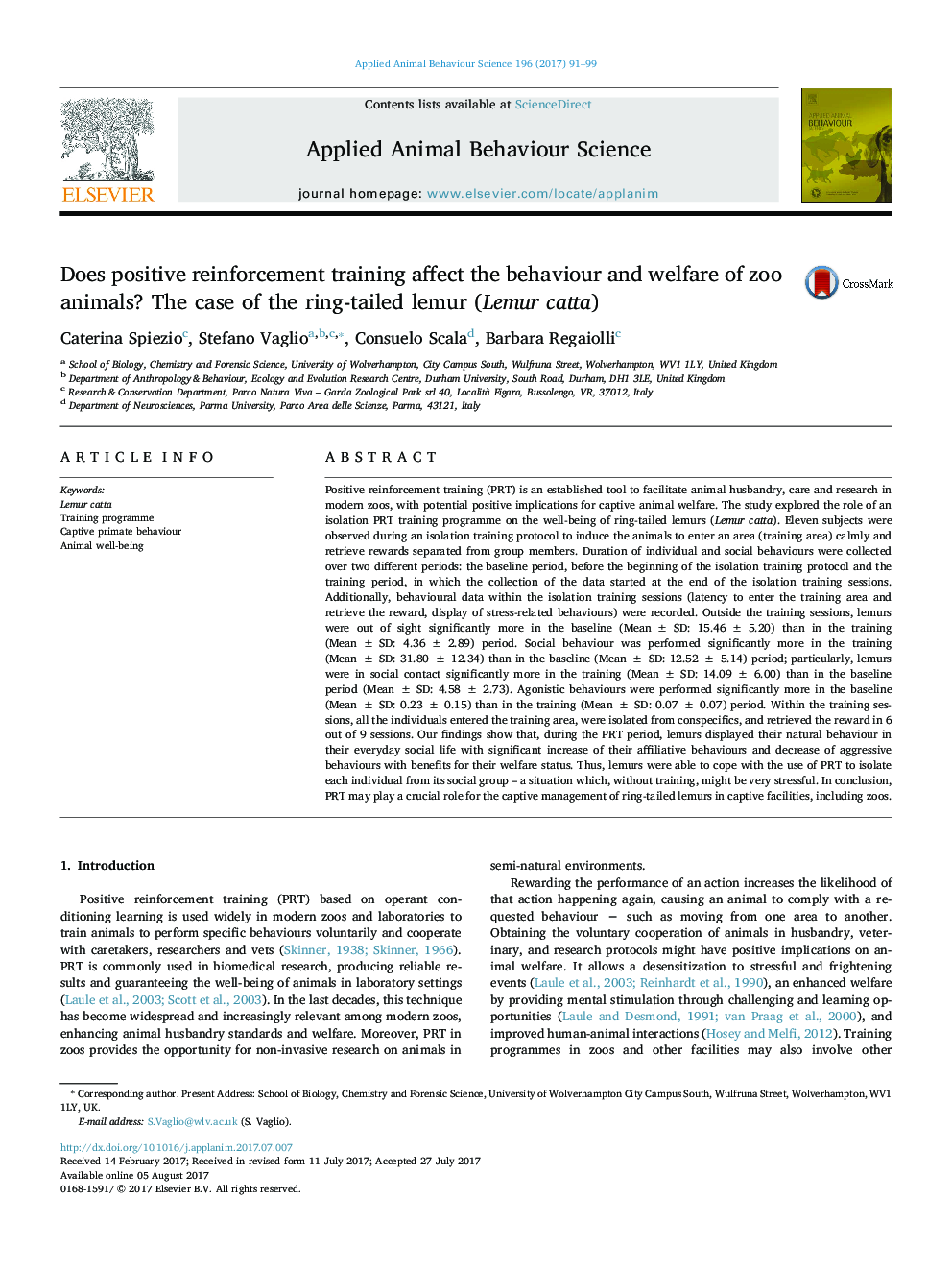| کد مقاله | کد نشریه | سال انتشار | مقاله انگلیسی | نسخه تمام متن |
|---|---|---|---|---|
| 5763231 | 1625310 | 2017 | 9 صفحه PDF | دانلود رایگان |
عنوان انگلیسی مقاله ISI
Does positive reinforcement training affect the behaviour and welfare of zoo animals? The case of the ring-tailed lemur (Lemur catta)
دانلود مقاله + سفارش ترجمه
دانلود مقاله ISI انگلیسی
رایگان برای ایرانیان
کلمات کلیدی
موضوعات مرتبط
علوم زیستی و بیوفناوری
علوم کشاورزی و بیولوژیک
علوم دامی و جانورشناسی
پیش نمایش صفحه اول مقاله

چکیده انگلیسی
Positive reinforcement training (PRT) is an established tool to facilitate animal husbandry, care and research in modern zoos, with potential positive implications for captive animal welfare. The study explored the role of an isolation PRT training programme on the well-being of ring-tailed lemurs (Lemur catta). Eleven subjects were observed during an isolation training protocol to induce the animals to enter an area (training area) calmly and retrieve rewards separated from group members. Duration of individual and social behaviours were collected over two different periods: the baseline period, before the beginning of the isolation training protocol and the training period, in which the collection of the data started at the end of the isolation training sessions. Additionally, behavioural data within the isolation training sessions (latency to enter the training area and retrieve the reward, display of stress-related behaviours) were recorded. Outside the training sessions, lemurs were out of sight significantly more in the baseline (Mean ± SD: 15.46 ± 5.20) than in the training (Mean ± SD: 4.36 ± 2.89) period. Social behaviour was performed significantly more in the training (Mean ± SD: 31.80 ± 12.34) than in the baseline (Mean ± SD: 12.52 ± 5.14) period; particularly, lemurs were in social contact significantly more in the training (Mean ± SD: 14.09 ± 6.00) than in the baseline period (Mean ± SD: 4.58 ± 2.73). Agonistic behaviours were performed significantly more in the baseline (Mean ± SD: 0.23 ± 0.15) than in the training (Mean ± SD: 0.07 ± 0.07) period. Within the training sessions, all the individuals entered the training area, were isolated from conspecifics, and retrieved the reward in 6 out of 9 sessions. Our findings show that, during the PRT period, lemurs displayed their natural behaviour in their everyday social life with significant increase of their affiliative behaviours and decrease of aggressive behaviours with benefits for their welfare status. Thus, lemurs were able to cope with the use of PRT to isolate each individual from its social group - a situation which, without training, might be very stressful. In conclusion, PRT may play a crucial role for the captive management of ring-tailed lemurs in captive facilities, including zoos.
ناشر
Database: Elsevier - ScienceDirect (ساینس دایرکت)
Journal: Applied Animal Behaviour Science - Volume 196, November 2017, Pages 91-99
Journal: Applied Animal Behaviour Science - Volume 196, November 2017, Pages 91-99
نویسندگان
Caterina Spiezio, Stefano Vaglio, Consuelo Scala, Barbara Regaiolli,